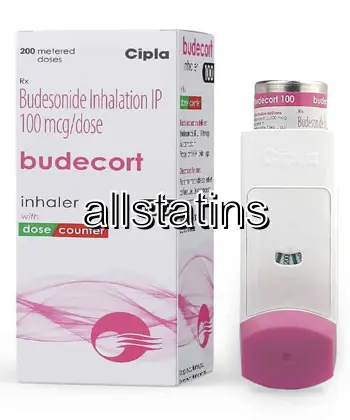| Package | Dosage | Price | Price per Dose | |
|---|---|---|---|---|
| Dosage: 100mcg | ||||
| 5 inhaler | 100mcg | AUD550.17 | AUD110.04 | |
| 4 inhaler | 100mcg | AUD488.74 | AUD122.19 | |
| 3 inhaler | 100mcg | AUD403.27 | AUD134.42 | |
| 2 inhaler | 100mcg | AUD317.80 | AUD158.89 | |
| 1 inhaler | 100mcg | AUD184.26 | AUD184.26 | |

Budecort Description
What is Budecort?
Budecort is an inhaled corticosteroid that contains budesonide. In Australia it is prescribed as a daily controller for asthma. It helps calm swelling in the airways and reduces coughing and wheeze. The medicine is delivered by an inhaler device, usually a Turbuhaler or another approved device. Use it regularly as advised by your doctor for the best long-term effect. It is not a rescue inhaler.
How Budecort helps in Australian care
In Australian practice, Budecort is often started as part of a long-term asthma plan. It lowers the frequency of symptoms and the need for urgent treatment. Many patients notice gradual benefits after a week or two with consistent use. Your doctor may adjust the dose based on how well your asthma is controlled. Always keep a fast-acting inhaler for sudden symptoms as part of your plan.
Who can use Budecort?
Budecort is intended for adults and for children when prescribed. The specific dose and device depend on age, asthma severity and other medicines. It is not suitable for immediate relief of an asthma attack. Tell your doctor about infections like thrush, and about any other medicines you take. Your clinician will tailor the plan to you.
How to use Budecort
Read the patient information leaflet that comes with your inhaler. Load the dose as directed for your device. Inhale slowly and evenly, then hold your breath for a few seconds. If you use a spacer, follow the spacer instructions. Rinse your mouth after inhalation to reduce throat irritation and prevent thrush. Do not exceed the prescribed dose and do not stop suddenly without medical advice. Keep track of how many puffs you have left.
Expected results and follow-up
Most people notice gradual improvement over days to weeks. If symptoms worsen or you have more flare-ups, contact your clinician. Regular reviews help adjust the dose for best control and to check for side effects. Do not change brands or devices without medical guidance.
Possible side effects
Common side effects include a sore throat, hoarse voice or coughing. Mouth thrush can occur if you don’t rinse after use. Headache and upset stomach are possible but less common. In rare cases, higher doses over a long period can affect growth in children or bone health. Seek advice if you notice signs of an allergic reaction.
Local patient review
A local Australian reviewer noted fewer daily symptoms after several weeks of Budecort. They could exercise more comfortably and sleep better during the night. They underline the importance of rinsing the mouth after use and using a spacer to improve comfort and inhaler performance. Overall, the experience was positive with adherence.
Pros and cons
Pros include reliable long-term control of asthma symptoms and the convenience of an inhaler. Some patients achieve good control with a once-daily or twice-daily dose depending on the plan. Cons include no quick relief during an attack and the need for daily use. Mouth care is important to prevent infections.
Storage and handling
Store Budecort in a cool, dry place away from moisture. Keep the inhaler cap closed when not in use. Do not transfer medicine to another container. Keep it out of reach of children. Replace the inhaler as advised by the label or your pharmacist, and dispose of empty devices properly.
Australian access and guidance
Budecort is prescribed by a clinician and may be subsidised under the PBS for eligible patients. Your pharmacist can help with the best device and technique. If you are unsure about steps, ask for a short in‑person demonstration or a video guide at the clinic. Regular follow-up is key to good control.
Safety in pregnancy and children
If you are pregnant or planning pregnancy, discuss Budecort with your doctor. In children, dosing is carefully adjusted and growth may be monitored during long-term use. Tell your clinician about all medicines to check for interactions. Do not start or stop any treatment without medical advice.